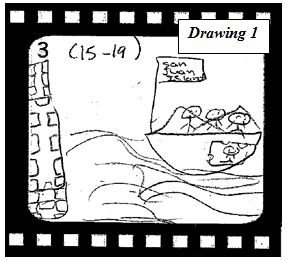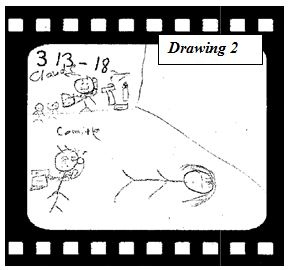|
| |
Drawing Tasks for Beginning-Level Readers At intermediate and advanced levels, there are a variety of means to evaluate students’ comprehension of reading material. They might answer true/false or multiple choice questions about details in the reading. Furthermore, they can participate in discussions on the reading topic or summarize main points in writing. At intermediate and advanced levels, there are a variety of means to evaluate students’ comprehension of reading material. They might answer true/false or multiple choice questions about details in the reading. Furthermore, they can participate in discussions on the reading topic or summarize main points in writing.The task of evaluating how well students understand a reading passage becomes more difficult with beginning-level students. With more limited vocabulary and structures available for use, it becomes more difficult to create true/false or multiple choice questions that do not themselves challenge student understanding. Furthermore, because receptive understanding of vocabulary precedes the ability to productively communicate using it, these beginning-level students may indeed comprehend a text but have difficulty expressing this through oral discussion or through writing. I’ve found that one solution to this dilemma is to ask students to represent their understanding of a story with a series of pictures rather than words. This activity can be done as an in-class learning activity or as homework and has worked well with my class for several different reasons. When setting up this task, it works best to give students a specific number of panels to complete in their series of drawings. A useful graphic organizer with six panels can be found through the web site edHelper.com. Also, instruct students about which sentences to represent in each panel, using paragraph or line numbers if available. This works well because when students engage in this task, it steers them away from translating individual words and towards forming a representation of ideas. Also, for the teacher, these drawings do provide useful insights into student understanding. Drawing 1 is a student’s depiction of these lines from the Basic Reading Power 1 story “A Day Trip to Mexico”: He then saw a sign on a boat. It said, “San Juan.” Anthony looked around. He didn’t see any people, so he got on the boat. There were some large boxes on the boat. He got into a box and closed it. After a few minutes, he heard some men on the boat. Soon the boat started to move. Through some holes in the boxes, Anthony could look out. He saw the buildings of Seattle, and then he saw only the sea. (Jeffries, 2009, p. 33)
 This drawing illustrates the student’s understanding of a range of details, from the boat’s sign to the holes in the box. Also, at times, this activity is able to highlight a student’s miscomprehension so that it can be addressed. Drawing 2 is based on this text in the Basic Reading Power 1 story “The Telephone Call”: She went to the telephone, and she pushed some numbers. A man answered her call. He was an engineer named Claude Armand. His office was in the city. He didn’t know Camille, and at first, he didn’t understand her. But he had children, and he understood there was a problem. (Jeffries, 2009, p. 32)
 Because the student drew children with Claude, I was able to see that she misunderstood the significance of “he had children” and its use to convey his ability to empathize rather than to tell about his current surroundings. This allowed us to discuss how the surrounding context affects meaning. Finally, drawing is generally considered a fun activity. We often reviewed a homework story in class by reading it and showing different students’ drawings. The students enjoyed laughing at their own and each other’s drawings in a good-natured way, which lowered the affective filter in the class. Students enjoy and benefit from this activity, and it can be extended in a variety of ways. In a multi-skill classroom, for example, students might retell the story using their pictures but not the text to practice speaking. Or, half of the class could be given one story and the other half another. The teacher could have students cut up their pictures and exchange them with someone who read the other story. Then, when reading the new story, students could match their partners’ pictures to the new text. Biography Kathleen Montgomery is a Continuing Lecturer and the Listening/Speaking Coordinator for the English Language Program at Purdue University Calumet. References Jeffries, L., & Mikulecky, B. (2009). Basic reading power 1: Extensive reading, vocabulary building, comprehension skills, thinking skills (3rd ed.). White Plains, NY: Pearson Longman. | |
| ITBE Link - Fall 2014 - Volume 42 Number 3 |